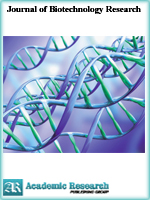Journal of Biotechnology Research
Online ISSN: 2413-3256
Print ISSN: 2413-8878
Print ISSN: 2413-8878
Quarterly Published (4 Issues Per Year)

Archives
Volume 6 Number 7 July 2020
Prediction and Recognition of Gram-Negative Bacterial Promoter Sequences: An Analysis of Available Web Tools
Authors: Hugo André Klauck ; Gabriel Dall’Alba ; Scheila de Avila e Silva ; Ana Paula Longaray Delamare
Pages: 90-97
DOI: doi.org/10.32861/jbr.67.90.97
Abstract
Many computational methods aim to improve the prediction and recognition of transcription elements in prokaryotes. Despite this, the natural features of those elements make their prediction and recognition remain as an open field of research. In this paper, we compared the open-access tools BacPP, BPROM, bTSSfinder, CNNPromoter_b, iPro70-PseZNC, NNPP2, PePPer, and PromPredict. First, we listed the overall functionalities of each tool and the resources available on their web pages. Later, we carried out a comparison of prediction results using 206 intergenic regions. When evaluating the prediction using intergenic regions containing a single promoter within each, NNPP2 and BacPP obtained >90% correct predictions, with NNPP2 obtaining the highest values of match between predicted promoter location and location indicated by RegulonDB. Overall, many discrepancies were observed among the results. They may be explained by the differences in the methodologies that each tool applies for promoter prediction, not excluding the natural features of promoters as a factor as well. In any case, the results highlight the necessity to continue the efforts to improve promoter prediction, perhaps combining multiple approaches. Through said efforts, some of the challenges of the postgenomic era may be tackled as well.
Mycological Assessment of Deteriorated Lycopersicum esculentum Fruits Sold in Wukari Nigeria
Authors: Ogodo A. C. ; Agwaranze D. I. ; Kalu A. C. ; Sabo I. A. ; Aso R. E. ; Okachi M. A.
Pages: 84-89
DOI: doi.org/10.32861/jbr.67.84.89
Abstract
Lycopersicum esculentum (Tomato) fruits are widely consumed in raw and processed forms owing to their high nutritional value. However, high water content makes them more prone to microbial attack especially spoilage by fungi. In this study, fungi associated with deteriorated tomato fruits sold in Wukari, Nigeria were assessed. A total of thirty (30) deteriorated tomato fruits were collected, ten (10) each from the three markets (Federal University up-gate mini market, New market and Yam market) and assessed for fungi using standard microbiological methods. The result shows that fungal load in all the markets ranged from 1.0 × 105 sfu/g to 3.0 × 105 sfu/g and Aspergillus niger, Aspergillus flavus, Rhodotorula species, Mucor species, Saccharomyces cerevisiae and Fusarium species were isolated from the various samples. The percentage occurrences of the various isolates on the samples show that Aspergillus niger was the most frequent (63.33%), followed by Fusarium species (43.33%), Aspergillus flavus (33.33%), Mucor species (26.67%) and Rhodotorula species (23.33%) while Saccharomyces cerevisiae (10.00%) was the least. In each sampling location, the percentage occurrences of all the species were highest at Yam market site (35%), followed by Federal University up-gate mini market (33.33%) while New market site was the least (31.67%). The pathogenicity result showed that the healthy tomato fruits after being inoculated with these fungi isolates deteriorated spontaneously through the period of 5 days and the organisms were recovered after culture on freshly prepared nutrient medium. Some of these organisms are known to be human pathogens, hence care must be taken when handling and using deteriorated tomatoes to avoid infections from these organisms.



